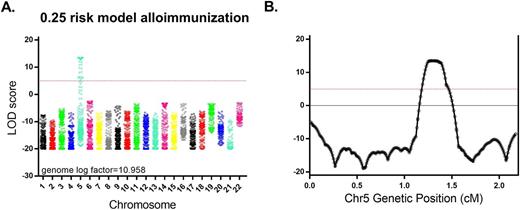Abstract
Background: Transfusion is a standard treatment for acute and chronic complications of sickle cell disease (SCD). This therapy is limited by a high prevalence of red cell antigen alloimmunization, which is not seen in other frequently transfused patient populations. Reasons for this increased prevalence have not been elucidated. One model based study suggested a genetic predisposition in all patient populations. Other studies have provided evidence that antigen mismatches occur commonly between blood donors of European ancestry and SCD patients and that this is a primary cause for alloimmunization. Accordingly, limited phenotypic antigen matching is a standard practice used to minimize alloimmunization risk. We hypothesized that if these population differences are the biologic basis for this phenomenon that admixture mapping could identify significant susceptibility loci.
Methods: A cohort study consisting of adults evaluated at NIH and Howard University between 2001-2015 (n=721) had allo-antibody status confirmed with the blood bank at the hospital where the most recent transfusion was performed. Genomic DNA was genotyped for a panel of 1622 ancestry informative SNPs in 359 patients. Genotypes were used to infer ancestry proportions using Structure software assuming a 3 population model. Ancestry was analyzed by regression along with clinical variables. Genome wide admixture mapping was performed to identify regions of the genome where ancestry differences between cases and controls suggested an association. We used AncestryMap for a log-additive case control study assuming various risk models.
Results: Five hundred fifty four subjects (77% of cohort) had a transfusion history with 153 (27.6 %) with allo-antibodies and 65 (11.7 %) with no prior transfusions. Antibodies directed against RH, Kell, MNS and Duffy antigens were the most prevalent. Clinical factors associated with alloimmunization in regression models were only significant for lifetime transfusion history by both logistic (antibody status, β=0.56, P=6.31 x 10-6) and linear (number of antibodies, β=0.35, P=0.0004) regressions. When considering genotype data, Amerindian ancestry was associated with antibody status (logistic, β=4.60, P=0.03) and number of antibodies (linear, β=4.92, P=0.006), while African and European ancestry were not. The association between ancestry and alloimmunization risk remained unchanged when the number of prior transfusions was also included in both multivariable models for alloimmunization status and number of antibodies, P=0.09 and P=0.06, respectively. Genome wide mapping by admixture linkage disequilibrium compared 91 allo-Ab cases to 210 controls with prior transfusions under 10 different risk models (range 0.25-9.0). The most significant result was the 0.25 risk model which was highly suggestive for association (genome log factor 10.96, P<0.001; Figure 1A). This scan identified region of chromosome 5 (5q21.3-5q31.1) defined by 14 snps spanning 21.685 Mb and a highly significant peak LOD score of 13.5 (Figure 1B). While this region contains >540 genes, the linkage region is noteworthy for a cytokine gene cluster implicated in hematopoiesis and immune responses.
Conclusions: In a large cohort of adults with SCD, the prevalence of red cell alloimmunization is 27.6%. Amerindian ancestry is a risk factor and suggests a genetic component to this phenotype. The number of prior transfusions is also a significant risk factor. Genome wide admixture mapping identified a strong association at chromosome 5q21.3-5q31.1 using a 0.25 risk model. This chromosome 5 association is particularly interesting given the presence a cytokine gene cluster within a portion of the associated region. Analysis of larger, admixed populations will help to fine map allo-immunization susceptibility variants within specific genes that underlie these loci.
No relevant conflicts of interest to declare.
Author notes
Asterisk with author names denotes non-ASH members.


This feature is available to Subscribers Only
Sign In or Create an Account Close Modal